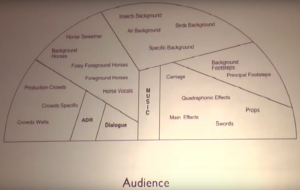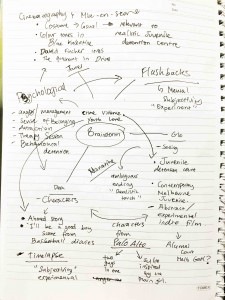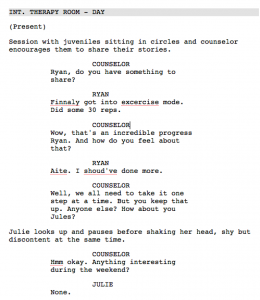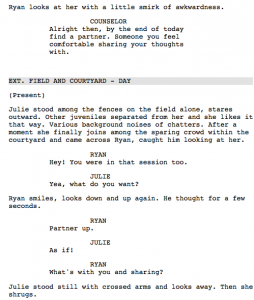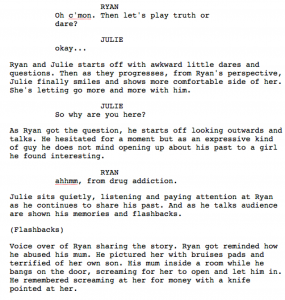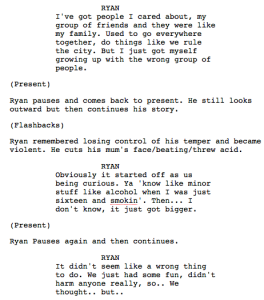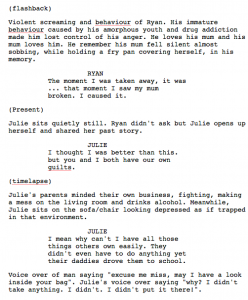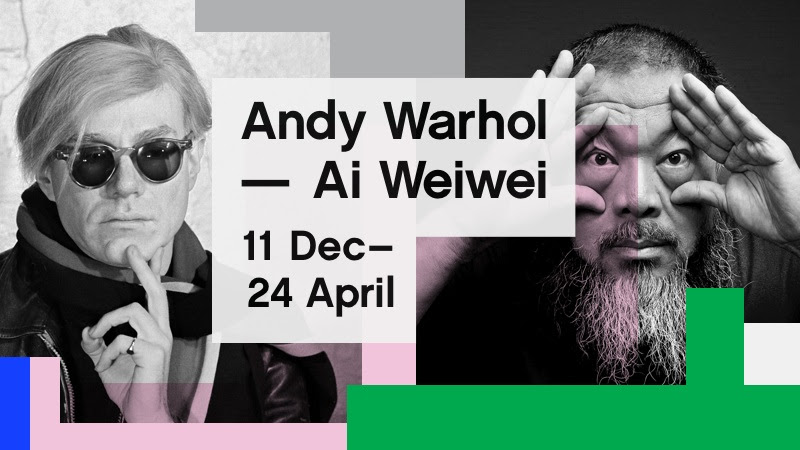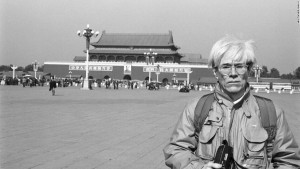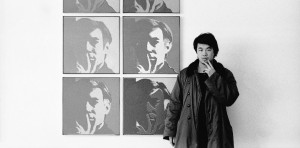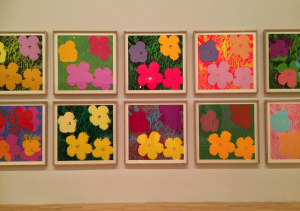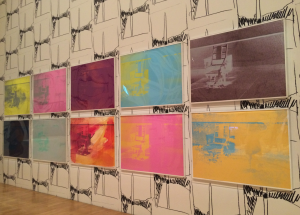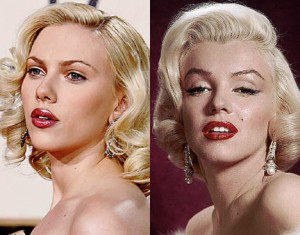https://www.facebook.com/CityCentreAlexandria/videos/1320241638018576/
Inspirations
What Juvies sounds like
The sound design of our film would be the experimental aspects for me into trying out different methods whilst producing the piece. What I’m aiming to play out for the audience is for them to hear a correlation of sounds to the character’s mental subjectivity. Whether it is the sound of running water to portray calmness and security, or upbeat intense bass sounds to portray discomfort or emotional instability. To put on unique kind of sounds orchestrated as a unity would be something I am excited to experiment on. Walter Murch mentioned..
Similarly, I would put the dialogue or voice overs as the more dominating sound for the film. But rather for music, I thought of putting it as a subtle supporter of the character’s situations, which takes its place more towards the back or the sides of the orchestra. Instead, environmental sounds are equally important to portray the character’s mental subjectivity and emotions in which then would be placed among the sides of the orchestra.
These sort of sounds curated are of environmental sounds that naturalistic and may take part in our film. We need these sounds to enhance the sense of realism and a more pronounced way of how individuals hear their surroundings. Characters are therefore correlated with environmental sounds as if that is what they are listening to or hearing what they take in from their environment. Again, that will contribute into conveying their mental subjectivity.
- Water running; taps, fountains, waves
- Wind
- Trams
- People chattering
- Sounds of doors
- Breathing
- Footsteps
Music and rhythmic melodies that I have found from free music archive websites are crucial into creating that aura of dramatic tones. These background musics allow us to generate a more impactful effects towards the audience. It serves as a bridge in connecting the character’s emotions and engagement with the audience.
Upbeat and jumpy tones (White Limit):
- Excitement
- Ryan meeting/engaging with Julie
- Playful
- Interests of Ryan’s emotions
Jumpy tone (White Limit) with mellow tensity:
- Discomfort
- Emotional instability
- Journey/ experiences
- Flashbacks
Rock electric guitar (Let’s Make Hate):
- Adventurous side- Characters sharing stories
- Hardship of past experiences
- Crimes
Celeste clinking bowls (taken from NGV):
- Water creates calmness
- Randomness, the unpredictable pattern- symbolises character’s psychological and mental disorders

“Let’s Make Hate” music symbolises adventurous side of the two characters into sharing their stories and form their relationship. Also, the electric guitar rock kind of sound relates to the hardship of experienced they had all the crimes they did and their time in juvenile detention centre to modify themselves. The chill, slower but mellow tone of this music symbolises their never ending journey that they keep going on and that life goes on. Furthermore, during their slow pace along walking on their journey it shows that they don’t have to rush, and that in learning about their identity they need to take their time. The mental disorders and “messiness” is symbolised by the clicking bowls on the water sounds that are random and not in order, which also portrays that we cannot always predict the human mind.
Voice overs and dialogue corresponding to the background music in our film is inspired by one scene from Gia Coppola’s Palo Alto (2013).
‘Psych’ and Indie kind of characters
As Newman had mentioned, Indie films are more offbeat or personal or character-driven than Hollywood vibes (2011). I wanted to create this aura of a more character-focused narrative and their realistic experiences. Additionally, Indie films generally lacks generic framework, which again supports our vision and goal to generate an unexplained or ambiguous, realistic ending rather than the typical Hollywood happy-ending constructed narratives. So these main questions to think about now is crucial into our story development about drug uses and psychology of human being within contemporary juvenile detention centre.
What triggers Ryan’s anger toward the ending of the short film?
How did Julie calm him down?
Why is it that only Julie the one who can make Ryan calm and better in progress?
Before we answer these main questions, I would do a research about the psychology of drugs and alcohol relations with anger, aggression and violence. This research is for the purpose of our character, Ryan who still suffers anger management and emotional distress, while Dea takes upon a research about anxiety for our character, Julie. Ryan as we understood is a complex, expressive character who has some anger management problems. We thought it would be a great idea to reason his personalities and actions based on his pasts and drug/alcohol use.
Aggression (n): Any form of behaviour directed toward the goal of harming or injuring another living being who is motivated to avoid such treatment (Barron & Richardson, 1994).
Violence (n): Aggression involving physical harm or injury occurring between two or more human beings in the human literature (Pihl & Hoaken, 1997).
In our narrative, we have concluded that he had abused his mum out of need for his own selfish reasons. He wanted someone else’s money, for his own use of drugs and when he cannot receive what he needed, he gets angry. He hit his mum, physically and mentally harming her in which she is motivated to avoid his treatment. Therefore, we can say that Ryan is aggressive. But how his violent actions relate to his use of drug and alcohol is explored in a deeper psychological research that will aid us in constructing the short film’s narrative.
Does Ryan suffer an addiction to drugs? We chose a path where he was addicted and therefore in need of therapy within the detention centre. He also did consume a great amount of alcohol but coming from a low-income family, he mostly got the source from his old group of friends. According to Murdoch, Pihl, and Ross, individuals who are under the influence of alcohol will act aggressively (1990). These experts have also conducted a study in which offenders who had convicted a violent crime had been consuming alcohol shortly before. I was also thinking that if Ryan has a drug addiction which can lead to his anger management, what kind of drug can lead to such causes? Apparently, benzodiazepines has some links to increased anger and aggression (Dietch & Jennings, 1988). Like alcohol, the drug also affects the anxiety system. It also suggests an increased amount of violence much more than alcohol. These researches and findings allows me to provide a solid grounding into constructing the actions and behaviours as well as the identity of our characters portrayed in our film.
Taking these findings and inspirations into account, we are trying to explain the character’s motivation into his anger towards the end of the short film and embody a tint of Indie film characteristics. According to Newman, as Indie cinema is a genre constructed within its cultural discourse and concerns fairly ordinary people in recognisable places and situations (2011). He further explained that characters within Indie cinema experience realistic human everyday life, in which their world follows the same rules as we in real life experience.
Therefore to answer our main questions, Ryan lets go of his emotion after opening up to Julie due to his guilts regarding his abuse towards his mother. He remembered his mother getting hurt and he knows he caused it despite not having able to control his drug/alcohol-triggered violence. He is angry of himself and shameful, but as he is able to find someone who he can really express his true experiences and crimes, Julie acts as a catalyst and allows him to put himself back to his pasts and incidents. By this he is reminded of his past and thus, lost control of himself once again. This is what has triggered him to his disturbances and emotional breakdown towards the end of the narrative.
viewers encouraged to see these independent films as more socially engaged and formally experimental than Hollywood.
We’re OTW
Ideas-in-progress
My group and I first started developing ideas through a brainstorm, including various different sources and inspirations which connect to the prompt, “Where there is crime there’s violence, where there’s youth there’s love”. Everyone seems to have great interesting points, simple and succinct.
As we divided individual roles, I personally learned and experience something new as a whole. I have never written an ‘official’ script before and it really overwhelmed me as I started. Like most writers, I was totally blank. Dea was in charge of the character biography and development and therefore she had taken a part in developing our script. Because of our idea of character driven narrative, we tried to focus on our two main characters. Hence, the dense dialogue, mental subjectivity through flashbacks and time lapses and a heavy set of actions as well. What was challenging for me is to keep tying the script back to the main idea of youth and love and crime and violence. To add a little harmony to our experimental film without too much of the abstract touch, I though I could have a balance of both dialogue and action regulating in turns with each other.
Script-in-Progress
Character-in-progress
There are a number of inspirations for our characters. Most on real life youth stories with crime issues, but we have also taken parts of character portrayals from different outstanding films. These films often explore the psychological side of youth behaviour and mental subjectivities, which we are aiming to really focus on. This way we are able to tie the character back to our prompt and play around with our experimental indie style. Dea and I thought it would be a good idea to have some opposite personality clashing together. For example Ryan, the main character is an expressive guy in his early 20s with the problem of anger management and violent behaviour caused by various reasons including drug addiction. In contrast, Julie is a calm introvert needing sense of true belonging despite her closed up and almost-anti-social behaviour. What I think we need to do though, to dig deeper into the psychological theory side of these character bio is to do more research mainly on anxiety and drug issues.
- Story of Ahmed’s experience with drugs, mother and detention centre
- Basketball Diaries- Di Caprio’s character
- Youth development and characters on Palo Alto
- Background info- Juvenile justice system in Australia
https://www.youtube.com/watch?v=UCJYlFHvlYU
What’s Sound Design?
- Aid to filmmaker
- Aid to audience
- Manipulation of the audience
- Creation of a subjective environment
- Creation of a sympathetic environment
Here are some quotes from the Walter Murch playbook:
“It (sound) should strive to create a purposeful and fruitful tension between what is on the screen and what is kindled in the mind of the audience. The danger of present- day cinema is that it can suffocate its subjects by its very ability to represent them: it doesn’t possess the built-in escape valves of ambiguity that painting, music, literature, radio drama and black-and-white silent film automatically have simply by virtue of their sensory incompleteness — an incompleteness that engages the imagination of the viewer as compensation for what is only evoked by the artist.” -Walter Murch
“By comparison, film seems to be “all there” (it isn’t, but it seems to be), and thus the responsibility of filmmakers is to find ways within that completeness to refrain from achieving it. To that end, the metaphoric use of sound is one of the most fruitful, flexible and inexpensive means: by choosing carefully what to eliminate, and then adding back sounds that seem at first hearing to be somewhat at odds with the accompanying image, the filmmaker can open up a perceptual vacuum into which the mind of the audience must inevitably rush.” -Walter Murch
China-US Adaptations
Finally, I’ve made it to one of my favourite artists’ exhibition. Andy Warhol has been a long time inspiration to some of my artworks. I didn’t know much about Ai Wei Wei before, but these two guys clearly have some strong bond and connection among their artworks and identity. Both share common interest to comment on political issues, popular culture, and actually has visited each other’s residence. Andy Warhol has been in a Capitalist country, being born in America and therefore has been brought up with the free-spirited ideologies he has evidently produced in his works. On the other hand, Ai Weiwei being brought up in a Communist China made him an activist who has long inspired by Warhol’s “voice” in his works. Across their works, there is a dense number of similarities such as the use of repetition to imply mass productions, bold colours as pop aesthetics, similar drawings/sketches and etc. It is as if Ai Weiwei is an “adaptation” of Warhol just in a few decades. So I would also say that Ai WeiWei’s works are an imitation from those pop style of Andy Warhol.
Using Pop, Bold, Surrealistic colours:
Everywhere in our surroundings, there has to be an adaptation of the popular culture into at least one form of text. Textual crossing and adaptation does not have to be adjusted from a text into another form of medium, where text can also be adapted from cultural artefact. Needless to say, can we acknowledge that Marylin Monroe’s fashion style is adapted into the styles of celebrities we may see today? For instance, in Scarlett Johansson.
The art of self expression
Upon reading Michael Rabiger’s ‘You and the creative process‘, I came across the notion of self-discovery through constant production of your own passion. I, as a media practitioner still have no idea of what my own personal style, theme or identity presented among my films/artworks, in which why I am so interested in Rabiger’s article. I’ve learned that this self-exploration is indeed messy, slow and probably will never end. But we have to be willing to take chances yet courageous to trust and show who we are to the people around us just as he said “You cannot excel as an artist and stay in hiding”. Thus, it got me thinking and lead me to be a risk taker in order the become fully alive.
To express yourself is to master the art of non-conformity. Chris Guillebeau in his book discusses about creating your own ideal world. I understood that listening to your own thoughts and actually making them alive creates an inspiration. In Lynne Ramsey’s Small Deaths she expresses her true self of impressionistic creativity through her unique, unattached use of non-diegetic audio. She also cleverly conveyed a beautiful imperfection and rather broken cut editing such as jammed cutting shots repeated throughout parts of her film. This to me is a wonderful self-expression/discovery of the beauty in every individual’s imperfections. To her, the characters, visual and the audio aspects of a film is very important. Hence the details in cuts, unattached sounds, etc are little but powerful components. This way, Lynne Ramsey did push the boundaries of her comfort zone and took these risks.
Is art the same is therapy? Well, I’ve always thought whenever I have conflict emotionally, making art would help. Always thought that it is my own therapy and medicine to keep me satisfied with living. Apparently that’s not truly the case. The text states that if we do really need therapy to survive, it must be self-directed and art is not about self-direction, rather a creation that is meant to explore mysteries of human existence.
http://www.festival-cannes.com/en/theDailyArticle/60303.html
Guillebeau, C 2010, The Art of Non-Conformity, publish Penguin Group, edn. 1, New York.
Nolan’s “what in the world?”
First week in “Finding the Ear”
Our first week in this studio focuses on obviously, introduction. We did watch some clips from three widely-recognised filmmakers though; Martin Scorsese, Wes Anderson and Christopher Nolan. What most interests me is Christopher Nolan’s distinct and unique style across his films. Especially an analytical research on Nolan’s pattern of styles and filmic conventions across his different films. Nolan’s imagination of high concept within his films has been not only creating an idea outside the box, but it is like Nolan has also create his own circle somewhere in a space outside the box. This is like what is shown with the man killing his little self and in turn killed by a bigger self of him, in which can represents the idea of karma. I have learned that he consistently portray the sense of uncomfortable time passing through the use of clock ticking. Most of his characters has some kind of psychological instability or rather obsessive, as seen here in his short Doodlebug.
Another aspect I have noticed across his films are that he often present subjects within a subject as it is presented in Inception with the idea of dream within a dream. Similarly, Doodlebug with the character in a parallel world meeting himself in smaller size (and bigger). His usual film attributes chiaroscuro lighting, dark messages, slow camera movements and disturbing subjects (actors, setting, etc.) all determines film noir kind of filmic aesthetics. We can say that Nolan has mashed up different ideas and characteristics of film conventions combining them repeatedly to identify his own sense of auteur style. Thus, this leads me to encourage myself to find my own “voice” as a media practitioner, finding what I value and what my purpose is with my own style. Possibly in the future though, I am interested in different audience reactions to certain styles directors have communicated. This is because probably I do value the audience reactions as I communicate my ideas through films.
https://www.youtube.com/watch?v=-WhKt_CkXD0
http://www.imdb.com/title/tt0411302/reviews
Back to “life”, back to inspirations
This is my life now. Getting up for the purpose to do what you’re supposed to have passion for, which turns out to be such a pain. University. Media and Communication courses. Nevertheless, like other average person out there, we go to university because we’re supposed to, not because we want to learn. But to take authority in doing what we are supposed to in order to do what we want is cruical to my ritual as a media practitioner.
Having been enrolled in “Finding the Ear” studio is such a luck for me. I wanted to study the cinema and the filming bodyworks and its industry. So the first week of my second year was familiar. It is like being a new uni student in each course, but not really because you have already done this before. I guess I’ll just have to get used to it and see what happens as another year will pass like it did in a blink. But summer was awesome! Being in Bali while rushing to catch up on all the Oscars nominated films before the ceremony is like the heaven version of studying media. No such thing as official assignment. Period. But let’s be honest here, we’re not supposed to do this but we can’t help it anyway. Movie piracy is BIG in Bali, Indonesia. Even if you can avoid it, some movies aren’t even distributed it local cinemas, making us having to buy these movies to watch it anyway.
But during this holiday I have finally got to watch Room by an inspiring director, Lenny Abrahamson to create such a unique drama/thriller film. It is an adaptation of a book of the same name by Emma Donoghue. It is a film about a captive held in an enclosed and isolated room for seven years, being a victim of abduction. She was pregnant then and had a seven year old son never seeing the world outside and finally escaped to see it for the first time. What got me interested in this film is that despite its genre, the film is portrayed mostly in the child’s point of view and presented in his childish voice over as he narrates his perceptions. The film became a unique up-lifting presentation of the harsh-reality of thrilling world.
Another great film that had opened my eyes over the holidays is The Danish Girl, director by Tom Hooper. The film that made me cry after The Notebook (2004). Just because it reminded me of Caitlyn Jenner. It also got me thinking, is gender the same is sexuality?
High-Concept Cinema
When I think about Inception, its ambiguity always fascinate me and trigger an inspiration for my media practices. I’ve always been one interested in the ambiguity of a film such as Donnie Darko, Looper, Meshes of the Afternoon and Sex, Lies and Videotape which even influenced me to produce an abstract short film in media one as well as On The Frame brief four project.
Inception gives the freedom to its viewers to decide what they want to infer, leading to their own conclusions and respond to how the film “think”. In our week 9 studio Dan had put us into groups to write any thoughts and ideas about the film and this is what we came up with in the poster attached; all jumbled-up-drawings that “serves” as semiotics and messy writings. Inception not only portray the theories and psychology of the human mind, dreams and consciousness but does it in a way of thinking like a human being. With the use of loud heart-thumping soundtracks, matter of cognition with extreme slow motion corresponding to different levels of parallel consciousness (dream within a dream, the deeper the levels the faster we think), mise-en-scene according to different themes and architecture of the dreams and so on, Inception “thinks” and shows us the co-existance of perspectives and that there is no such thing as reality, only a perception (clearly because of different levels of the dream is of different person and also because of the ambiguity of the film’s ending). Hence, Dan set up different true/false statements on the screen and we had to decide where we stand, anywhere in the room, in which we agree to an extent.
“Cobb is dreaming the whole time.”
What an open ended topic which I guess left me question if Cobb is dreaming the whole time, the whole studio time. Someone else mentioned, “Which time?” and how does time actually work in the film where basically the film is an ambiguity especially of the timeframe and plot. We were not exactly sure and perhaps never will be, in regards to where Cobb actually is if he is free of his conviction or if he ended up in “limbo” where he is, in projection, free and went home to see his kids, who looked roughly the same age as what was shown in Cobb’s subjectivity before he got home. So the whole class had this argument. What I’ve concluded though, is that Cobb is not dreaming the whole time even when the shot cuts, not showing if the totem (Mal’s spinning top) does fall at the end of the film. Again, it is the understanding of off-screen space as Frampton pointed out. What is not shown on the frame does make a significant impact on my conclusions.
What we have here are notes and jumbled-up ideas my group and I came up with as we explore Inception.

